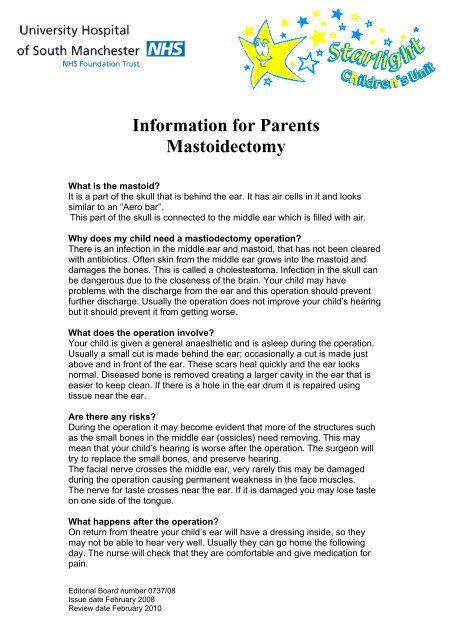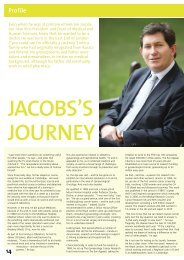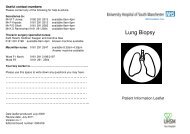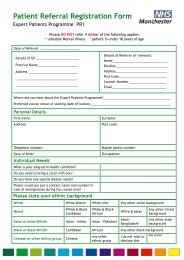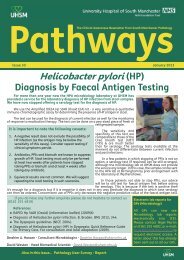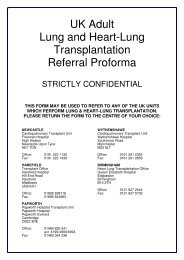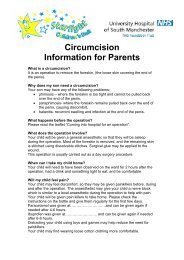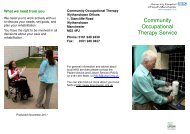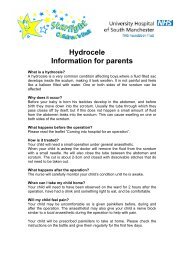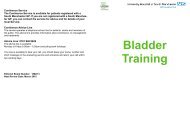Information for Parents Mastoidectomy - UHSM
Information for Parents Mastoidectomy - UHSM
Information for Parents Mastoidectomy - UHSM
Create successful ePaper yourself
Turn your PDF publications into a flip-book with our unique Google optimized e-Paper software.
<strong>In<strong>for</strong>mation</strong> <strong>for</strong> <strong>Parents</strong><br />
<strong>Mastoidectomy</strong><br />
What is the mastoid?<br />
It is a part of the skull that is behind the ear. It has air cells in it and looks<br />
similar to an “Aero bar”.<br />
This part of the skull is connected to the middle ear which is filled with air.<br />
Why does my child need a mastiodectomy operation?<br />
There is an infection in the middle ear and mastoid, that has not been cleared<br />
with antibiotics. Often skin from the middle ear grows into the mastoid and<br />
damages the bones. This is called a cholesteatoma. Infection in the skull can<br />
be dangerous due to the closeness of the brain. Your child may have<br />
problems with the discharge from the ear and this operation should prevent<br />
further discharge. Usually the operation does not improve your child’s hearing<br />
but it should prevent it from getting worse.<br />
What does the operation involve?<br />
Your child is given a general anaesthetic and is asleep during the operation.<br />
Usually a small cut is made behind the ear; occasionally a cut is made just<br />
above and in front of the ear. These scars heal quickly and the ear looks<br />
normal. Diseased bone is removed creating a larger cavity in the ear that is<br />
easier to keep clean. If there is a hole in the ear drum it is repaired using<br />
tissue near the ear.<br />
Are there any risks?<br />
During the operation it may become evident that more of the structures such<br />
as the small bones in the middle ear (ossicles) need removing. This may<br />
mean that your child’s hearing is worse after the operation. The surgeon will<br />
try to replace the small bones, and preserve hearing.<br />
The facial nerve crosses the middle ear, very rarely this may be damaged<br />
during the operation causing permanent weakness in the face muscles.<br />
The nerve <strong>for</strong> taste crosses near the ear. If it is damaged you may lose taste<br />
on one side of the tongue.<br />
What happens after the operation?<br />
On return from theatre your child’s ear will have a dressing inside, so they<br />
may not be able to hear very well. Usually they can go home the following<br />
day. The nurse will check that they are com<strong>for</strong>table and give medication <strong>for</strong><br />
pain.<br />
Editorial Board number 0737/08<br />
Issue date February 2008<br />
Review date February 2010
Will my child’s ear hurt?<br />
Your child’s ears can be uncom<strong>for</strong>table <strong>for</strong> the first few days. You will be given<br />
painkillers <strong>for</strong> your child to take at home. These need to be taken regularly <strong>for</strong><br />
the first few days follow the instructions on the bottle.<br />
Paracetamol was given at………………………….and can be taken again if<br />
needed 4-6 hourly.<br />
Ibroprofen was given at………………………. and can be taken again if<br />
needed 6-8 hourly.<br />
What will my child's ear feel like?<br />
Your child will have the bandages removed be<strong>for</strong>e they go home. There is a<br />
dressing inside the ear that is soaked in yellow antiseptic. This stays in the<br />
ear <strong>for</strong> a few weeks. It is usual <strong>for</strong> some discharge of yellow/bloodstained fluid<br />
from the ear <strong>for</strong> a few days. The ear will feel blocked up, and your child may<br />
feel dizzy <strong>for</strong> a few days.<br />
When can my child return to usual activities?<br />
• Your child can return to school in 2 weeks.<br />
• Avoid crowded places <strong>for</strong> 2 weeks.<br />
• Prevent the ear from getting wet until the dressing is removed from<br />
inside the ear. It may be necessary to keep the ear dry <strong>for</strong> up to 6<br />
months, depending on how quickly the ear heals.<br />
• Restrict your child from excessive activity <strong>for</strong> example riding their bike<br />
<strong>for</strong> 2 weeks.<br />
• Discourage your child from blowing their nose hard <strong>for</strong> 2 weeks.<br />
When will my child be seen again?<br />
Usually the wound is sealed with surgical glue, but if your child has stitches,<br />
please make an appointment with the practice nurse at your GP in 5-7 days to<br />
have these removed.<br />
You will be given an appointment to come back to the hospital in a few weeks.<br />
The ear can take up to 3 months to heal following a mastoid operation.<br />
Your child needs to come back to hospital or phone <strong>for</strong> advice if:<br />
• The ear discharge looks or smells infected,<br />
• there is any fresh bleeding through the bandage,<br />
• your child still has pain after taking the pain killers,<br />
• your child is generally unwell,<br />
• you are worried about your child.<br />
Children’s Day Unit 0161 291 2620<br />
Starlight Children’s ward:<br />
Team 1 0161 291 5458<br />
Team 2 0161 291 2248<br />
Written by Helen Fisher and Victoria Haworth in<br />
consultation with Mr Camillarie.<br />
Editorial Board number 0737/08<br />
Issue date February 2008<br />
Review date February 2010


